PERENNIALS > ANTIRRHINUM
Chris is a gardening writer and nature enthusiast. He graduated from Oxford Brookes University in 2022 with an MA in Psychology. Chris works with the Leeds Green Action Society, helping their food cooperative by growing various fruit and vegetables on their two allotments in Hyde Park, Leeds.
Reviewed By COLIN SKELLY

Colin is a Horticulturist and Horticultural Consultant with experience in a range of practical and managerial roles across heritage, commercial and public horticulture. He holds the Royal Horticultural Society’s Master of Horticulture award and has a particular interest in horticultural ecology and naturalistic planting for habitat and climate resilience.
IN THIS GUIDE
ANTIRRHINUM GUIDES
Antirrhinum, commonly known as ‘snapdragon’, is often thought of as an old-fashioned, country cottage plant, conjuring up memories of running through your grandparent’s garden as a child.
But these cheery, vibrant annual plants are making a keen comeback.
Snapdragons are easy to grow, bursting with colour, wonderfully fragrant and beloved by bees and other vital pollinators.
Blooming from April to June and August to October, these powerful plants come in a vast array of colours and various heights, and can really bring a dynamic twist to your garden.
Perfect for beds and borders, they also thrive in containers – making them perfect for any garden, regardless of the style or size.
Overview
| Botanical Name | Antirrhinum majus |
| Common Name(s) | Snapdragon |
| Plant Type | Perennial / Annual Flower |
| Native Area | Europe, North America, North Africa |
| Hardiness Rating | H3 |
| Foliage | Simple leaves |
| Flowers | Tubular, two-lipped flowers, solitary or in terminal racemes |
| Flowering Months | April, May, June, August, September |
| When To Prune | May, June, July, August, September |
Sunlight
Preferred
Full Sun
Exposure
Sheltered
Size
Height
0.1 – 0.5M
Spread
0.1 – 0.5M
Bloom Time
April – June / August – September
Soil
Preferred
Chalk, Loam, Sand
Moisture
Well drained
pH
Neutral / Alkaline
Snapdragons get their name thanks to their snout-shaped flowers which resemble the jaw of a dragon – the “dragon’s mouth” even opens and closes when squeezed laterally and makes a slight snapping sound.

The plants are said to represent both deception and graciousness.1Snapdragon Flower Meaning. (2017, March 21). Flower Meanings. Retrieved April 11, 2023, from https://www.flowermeaning.com/snapdragon-flower-meaning/
Whether all that is true remains to be seen, but an absolute fact is that they are stunning plants that are guaranteed to brighten up your garden.
Snapdragons fall into three different categories which are determined by their height and are as follows:
- Dwarf – measuring from 15-35cm in height
- Intermediate – measuring from 35-75cm in height
- Tall – measuring from 75-120cm in height
The variety in sizes makes this a multi-purpose plant well suited to bringing texture and structure to your garden. They’re also sure to complement other flowers.
Snapdragon Types
There are dozens of varieties of snapdragons, blooming in gorgeous colours of red, pink, orange, yellow, purple and white, as well as in bicolours, and both pastel shades to the brightest of hues.
With so many varieties to choose from, it can be hard to know where to start so we have picked out some of our favourites to help get you started.
Antirrhinum majus ‘Rocket’
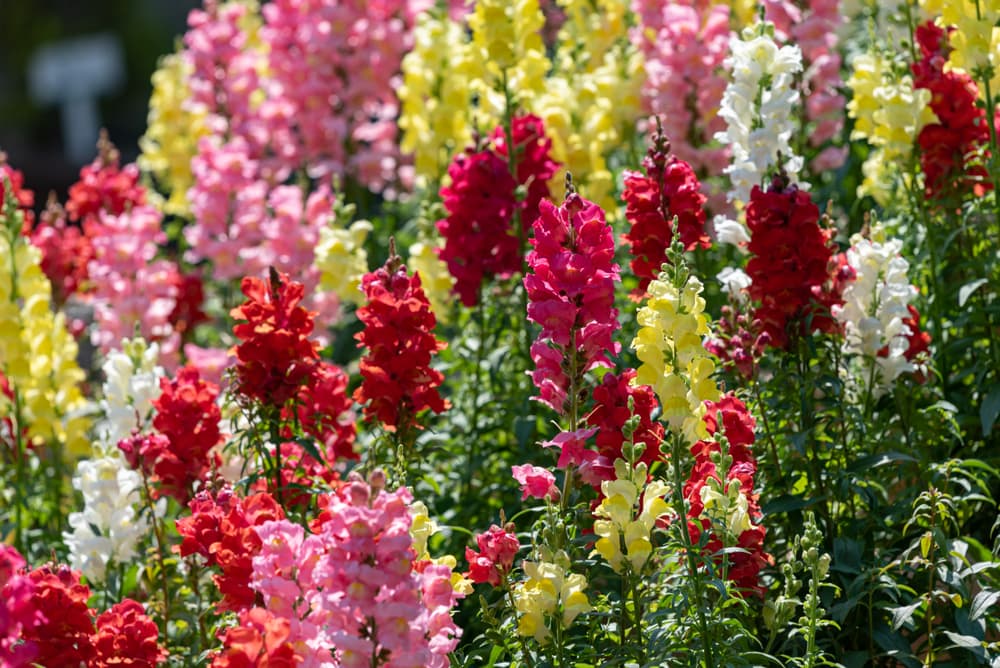
This lofty snapdragon grows to a height of around 90cm and comes in a variety of colours.
They have sturdy stems with florets that are closely set and are extremely tolerant of heat.
With eight colours to choose from they are a versatile option that are sure to bring a burst of colour to your garden.
A. majus ‘Black Prince’

Contrary to their name, black prince snapdragons actually have dark purple leaves and beautiful deep red flowers.
Growing up to 45cm in height, this variety enjoys warmer weather and will thrive in a spot where it can enjoy full sun.
A. majus ‘Royal Bride’

This traditional variety is one you will commonly see in the gardens of country cottages.
It blooms in pure “bride” white with a gorgeous dash of cream near its stem.
Royal bride snapdragons can reach heights of 90cm and have a glorious aroma.
Plant near paths or house entrances to enjoy their delicious scent.
A. majus ‘Tahiti’
This variety grows to a height of around 20cm and is among the tallest in the dwarf snapdragon category.
They are the ideal plant for garden bedding.
They don’t come in as many colours as many other types, but they make up for it with the option of bi-colour flowers.
They can be sown at almost any time of year and are perfect for rockeries, borders and containers.
A. majus ‘Madame Butterfly’
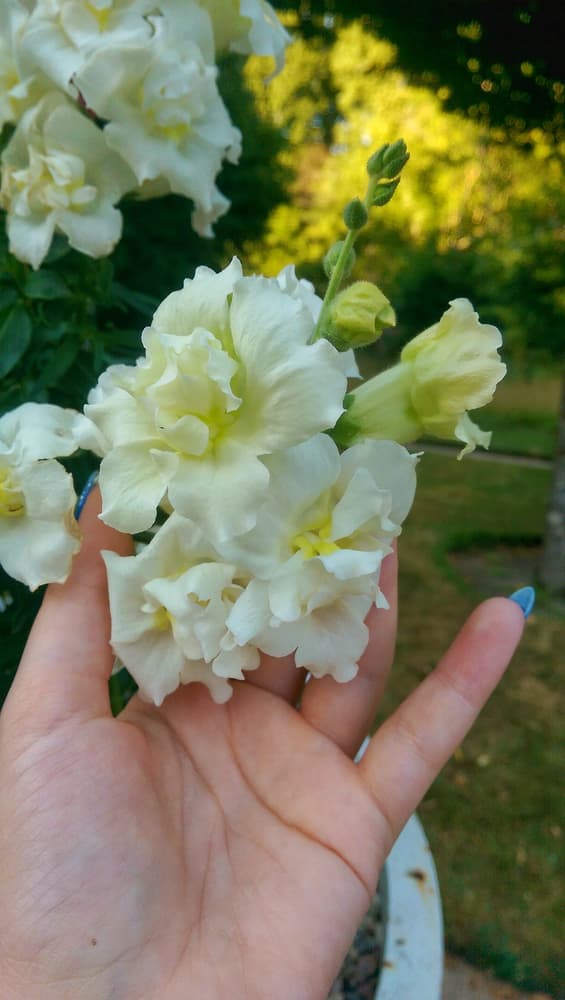
This showy specimen is a delightful cross between rocket and bright butterfly snapdragons.
Their flowers aren’t as open-faced as the butterflies but more so than the rocket.
The madame butterfly snapdragons have fluffy, azalea-shaped blooms and come in rich colours of red, orange, pink, yellow, white, purple and lavender.
Chandelier
This romantic variety of snapdragon is more of a trailing plant, with a bush-like quality.
Their flowers are a little smaller than other types, and if placed in a hanging basket, their blooms and leaves will cascade down with beautiful and dramatic effect.
How To Grow Snapdragons
Snapdragons are undemanding and easy to grow, making them perfect for novice gardeners or those of us with a busy schedule.
They are also a wonderful and rewarding plant to encourage children to learn about gardening.
I actually grew some from seed earlier this year. These were sown in my indoor propagator around late February, before being planted out in May.
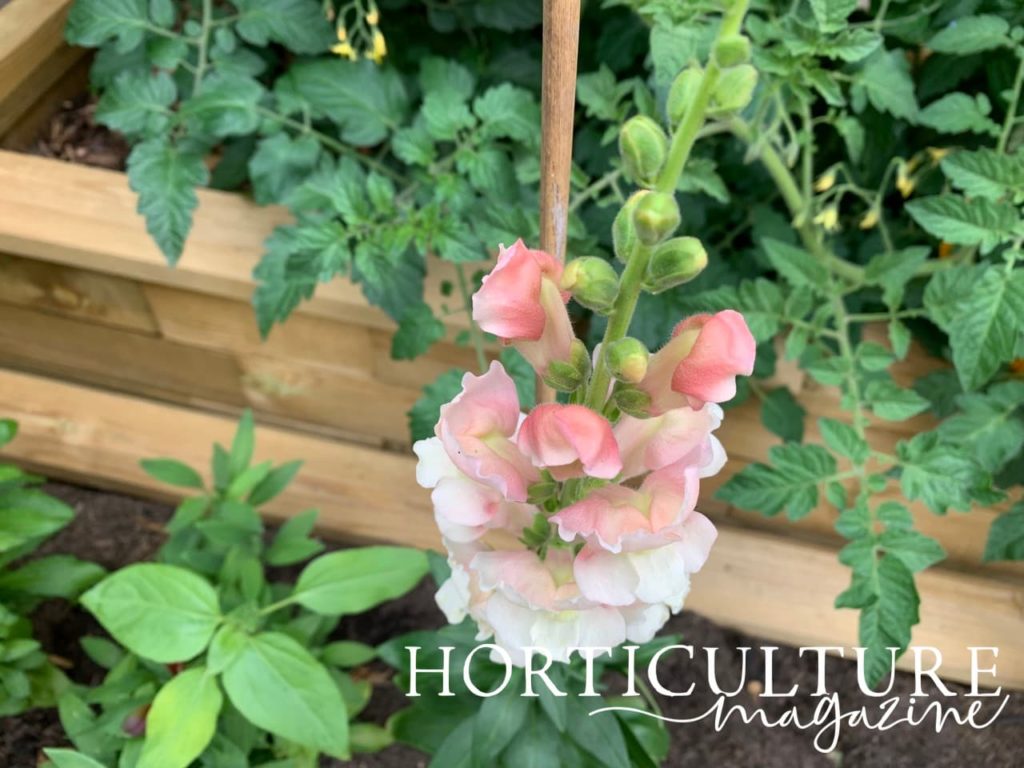
You can see that I managed to achieve some pretty spectacular flowers, though I did need to stake them with bamboo canes given we live in a really windy area!

At first I was worried I had planted them outside a little too early, as the foliage of the seedling showed signs of stress, but the plant slowly grew to life as summer approached and the weather got gradually warmer.
The pollinators loved them, and given that they were so easy to grow, I will definitely be growing even more this coming year.
“I grow dwarf Antirrhinums in my kitchen garden to enjoy as cut flowers but also to attract pollinators,” shares Master Horticulturist Colin Skelly.
“The shorter cultivars mean that I don’t have to worry about them collapsing over later in the summer.”
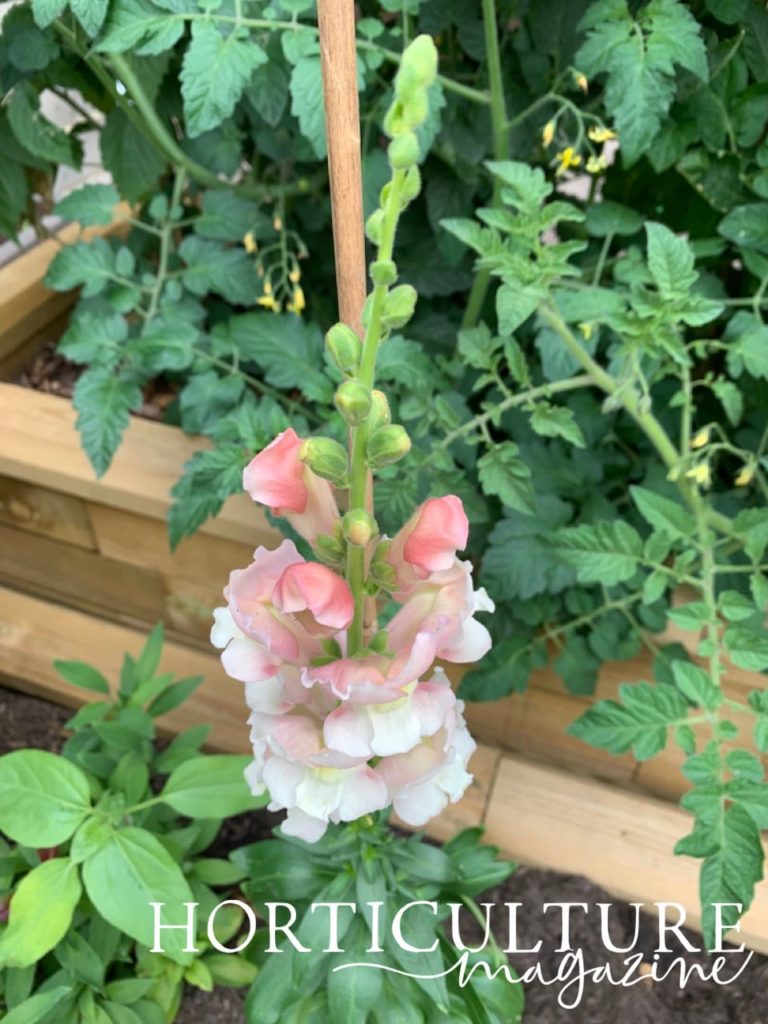
Many varieties will repeat bloom, but all of them tend to do best in the cooler months of spring and autumn.
If you are keen to introduce snapdragons into your garden then but aren’t sure where to begin, we have put together a complete guide to growing and caring for these spectacular plants.
Soil
Snapdragons are not too fussy, but they do prefer moist, well-drained soil.
Being short-lived plants, they aren’t heavy feeders but, they will appreciate it if you add a layer of organic matter to keep them healthy and happy.
Sunlight

If you want to get the most out of your snapdragons, then plant them in full sun to partial shade.
Opting for partial shade and keeping them well watered will give them more of a chance to make it through summer and will often bloom again in autumn.
Planting
You can sow snapdragon seeds in early spring or autumn.
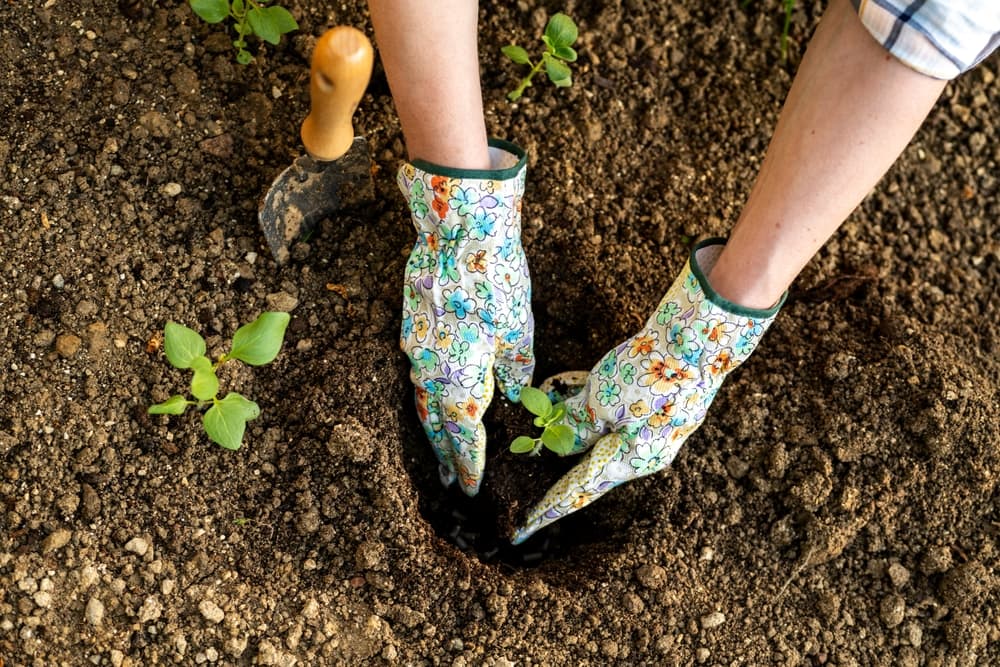
When large enough to handle you can transfer the seeds into pots or containers and place in a sheltered spot.
If you are planting them in beds or borders, then be sure to do so after the threat of frost.
Water
Snapdragons are thirsty plants, so make sure you provide them with adequate water.

Once established, they require an inch of water a week if there has been no rain – but be sure not to over-water.
You should also avoid overhead watering and instead aim for the crown.
Propagating
With their prolific flowering and beautiful colours, you will likely want to introduce these plants into other parts of your garden or share them with family or friends.
You can divide snapdragon plant roots by digging the plant up at the end of summer.
Divide the root mass into as many pieces as you desire and then plant each division into a large container.

You will need to keep the container indoors throughout winter and then plant into the garden the following spring.
It is worth mentioning however that these plants establish quickly, so if you don’t have luck with propagation it is easy to replace them with fresh new snapdragons.
Common Problems
Snapdragons generally have few problems with pests, and although diseases are uncommon, the main things to watch out for are powdery and downy mildew, and Botrytis blight.
There are many options for getting rid of powdery and downy mildew.

Botrytis blight is a little trickier, but first and foremost be sure to disinfect pruners between cuts to prevent the spread of this disease.
It’s then advisable to destroy infected plant material; this will also prevent it from spreading to nearby plants.
Snapdragons are real show-stoppers, producing long-lasting, dazzling displays of colour and elegance.
Their boastful blooms can bring exquisite interest to your garden for much of the year, so there’s every reason to include them.

These plants are so easy to grow, thoroughly rewarding and, they won’t just make your garden snap, they’ll make it snap, crackle and pop!
References
- 1Snapdragon Flower Meaning. (2017, March 21). Flower Meanings. Retrieved April 11, 2023, from https://www.flowermeaning.com/snapdragon-flower-meaning/

